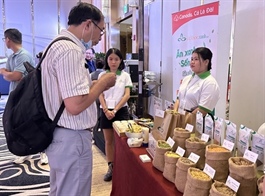GI salt yields rebound, but no exports yet
GI salt yields rebound, but no exports yet
Although “Kampot-Kep Salt” was domestically registered as a geographical indication (GI) late last month, distribution and export plans have been slow to materialise, even with roughly 67 kilotonnes harvested this season by end-April, according to Bun Narin, the head of the association in charge of the GI.
On April 26, the Ministry of Commerce “launched” three new GIs and four “collective marks”, at a ceremony representing formal recognition of the seven products’ inclusion into the Cambodian registry as well as their accompanying protections.
The three GIs were “Kampot-Kep Salt”, “Kampot-Kep Fish Sauce” and the “Takeo Crayfish”, and the four collective marks were “Ambok Kampong Thom” (Kampong Thom Rice Flakes), “Doung Khtis Battambang” (Battambang Wax Coconut), “Koh Trong Pomelo” and “Nom Banh Chok Siem Reap” (a local variety of rice noodle).
The registration of the GIs and collective marks, along with the government’s affirmation, will unlock the export potential of these regional products and give their associated communities a range of support mechanisms, according to stakeholders who have expressed hope that these goods will find widespread favour among overseas consumers.
A GI is an intellectual property (IP) tool that protects products originating or otherwise closely associated with a specific geographical region and that possess distinctive qualities, reputations or other traits fundamentally attributable to their territory of origin. GI items typically come with a managing association, as well as a name, sign or symbol to distinguish them from unauthorised copies.
Narin, president of the Association of Geographical Indication Kampot-Kep Salt Producers, told The Post on May 22 that the body has opted to undertake preliminary promotional work with producers and stakeholders as well as prepare packaging before releasing the GI product to domestic or international markets, despite strong interest from consumers, local distributors, and exporters.
“We need more time to get ready to market its qualities – including quality, flavour, and safety – to consumers. As scheduled, the association will host a workshop in August to promote the GI salt. Consumers, particularly salt exporters, are expected to attend,” he said.
He claimed that because Kampot-Kep salt is a high-quality and natural salt, its launch as a GI product is benefiting individuals involved in its production in several ways, including by driving up prices – potentially doubling them in some cases – and facilitating access to broader domestic and international markets.
“I expect that once the packaging is ready, there’ll be overseas demand for our salt at prices from 30,000-40,000 riel [$7.50-10] per [50kg] sack, compared to the current rates between 25,000 and 30,000 riel,” Narin said.
According to him, GI salt production has reached some 67 kilotonnes this season thanks to hot and otherwise favourable weather conditions, with some 40-50 kilotonnes purchased as of end-April. The commodity is produced on more than 3,000ha of land, with over 120 households involved in the process.
The GI salt could soon sell for 30,000-40,000 riel ($7.50-10), compared to the current rates between 25,000 and 30,000 riel, according to industry veteran Bun Narin. POST STAFF
The coastal provinces of Kampot and Kep are Cambodia’s primary salt producers, and the harvest season typically lasts from late December to mid-May, or even until June with hotter and drier conditions.
According to Kampot provincial Department of Industry, Science, Technology and Innovation director Sok Kim Choeun, sufficiently high temperatures, minimal rainfall and otherwise favourable weather conditions over three consecutive months during the Cambodian salt season could bring output up to more than 100 kilotonnes, in excess of annual domestic demand with plenty left for storage.
The Ministry of Industry, Science, Technology and Innovation reported that the total area under salt production in Kampot and Kep provinces was 4,748ha in 2021 and had not significantly changed in 2022, with each hectare yielding an average of 20 tonnes each year under good weather conditions.
To recap, official figures indicate that salt output in the Kingdom increased dramatically from 80 kilotonnes in 2013 to 147 in 2014 and then to 175 in 2015, before falling back to 143 kilotonnes in 2016.
Production then plunged to a mere 33 kilotonnes in 2017, further dipped in 2018, and then again in 2019.
According to Kim Choeun, output rocketed to 105 kilotonnes in 2020 – 85 from Kampot and 20 from Kep. By comparison, the ministry’s Department of Handicraft Affairs reported that Cambodia produced more than 75 kilotonnes of salt in 2021, down by over 20 kilotonnes from a year earlier.
Last year, heavy rainfall reduced salt production to 30-40 kilotonnes, according to insider reports, despite estimates placing the annual domestic demand at 70-100 kilotonnes.














